technical data SKODA OCTAVIA 2009 2.G / (1Z) Owner's Guide
[x] Cancel search | Manufacturer: SKODA, Model Year: 2009, Model line: OCTAVIA, Model: SKODA OCTAVIA 2009 2.G / (1Z)Pages: 304, PDF Size: 19.56 MB
Page 42 of 304
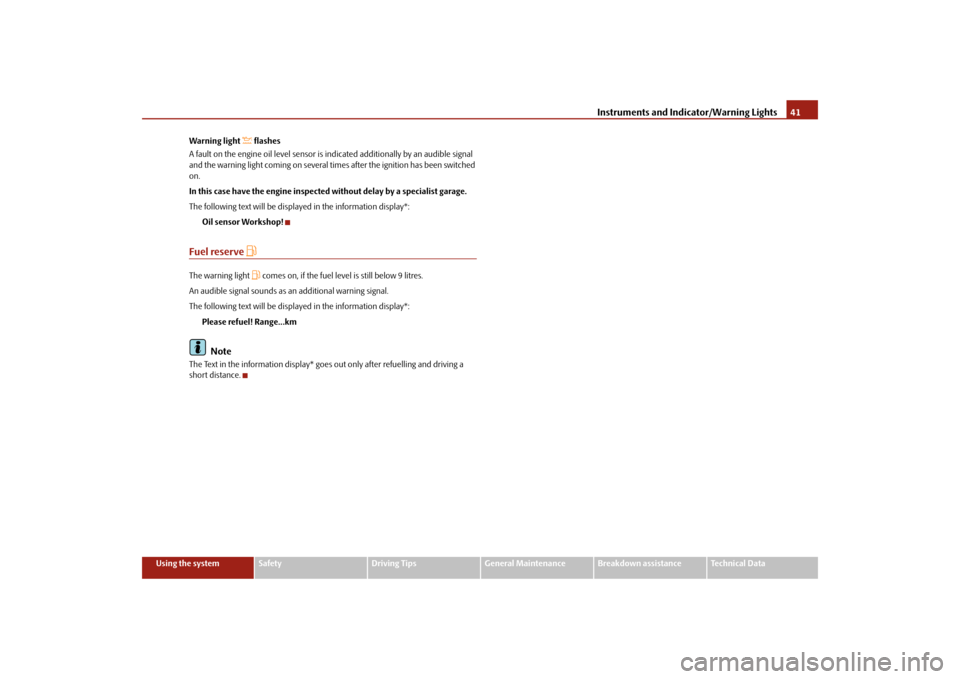
Instruments and Indicator/Warning Lights
41
Using the system
Safety
Driving Tips
General Maintenance
Breakdown assistance
Technical Data
Warning light
flashes
A fault on the engine oil level sensor is indicated additionally by an audible signal and the warning light coming on several times after the ignition has been switched on. In this case have the engine inspected without delay by a specialist garage.The following text will be displayed in the information display*:
Oil sensor Workshop!
Fuel reserve
The warning light
comes on, if the fuel level is still below 9 litres.
An audible signal sounds as an additional warning signal.The following text will be displayed in the information display*:
Please refuel! Range...kmNote
The Text in the information display* goes out only after refuelling and driving a short distance.
se0.1.book Page 41 Friday, April 10, 2009 3:19 PM
Page 44 of 304
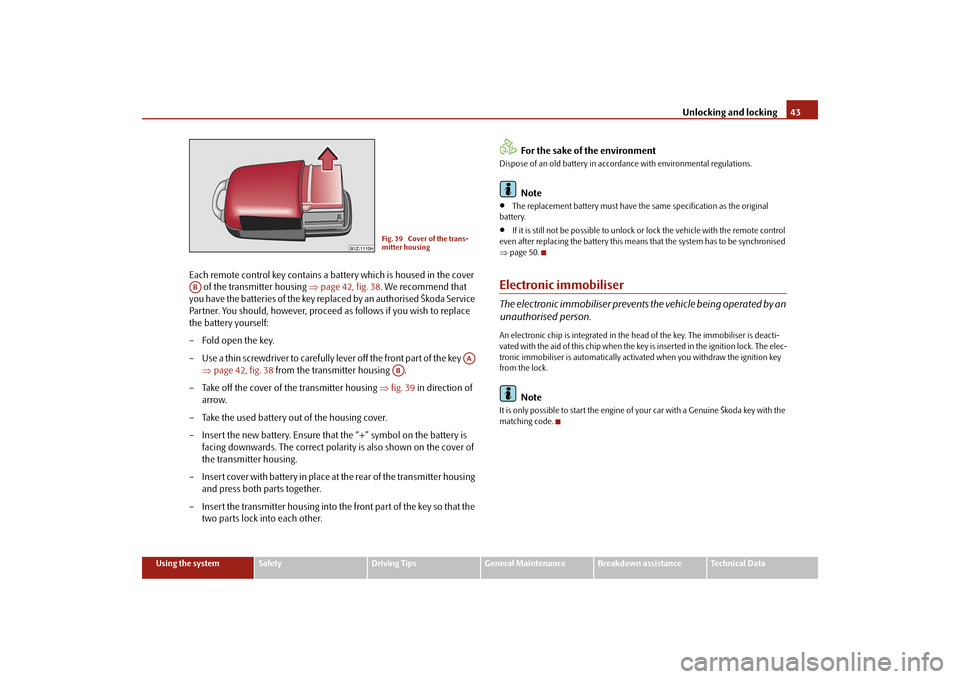
Unlocking and locking
43
Using the system
Safety
Driving Tips
General Maintenance
Breakdown assistance
Technical Data
Each remote control key contains a battery which is housed in the cover
of the transmitter housing
⇒
page 42, fig. 38
. We recommend that
you have the batteries of the key repl
aced by an authorised Škoda Service
Partner. You should, however, proceed as follows if you wish to replace the battery yourself: – Fold open the key. – Use a thin screwdriver to carefully
lever off the front part of the key
⇒
page 42, fig. 38
from the transmitter housing .
– Take off the cover of the transmitter housing
⇒
fig. 39
in direction of
arrow.
– Take the used battery out of the housing cover. – Insert the new battery. Ensure that the “+” symbol on the battery is
facing downwards. The correct polarity is also shown on the cover of the transmitter housing.
– Insert cover with battery in place at the rear of the transmitter housing
and press both parts together.
– Insert the transmitter housing into th
e front part of the key so that the
two parts lock into each other.
For the sake of the environment
Dispose of an old battery in accord
ance with environmental regulations.
Note
•
The replacement battery must have the same specification as the original
battery.•
If it is still not be possible to unlock or
lock the vehicle with the remote control
even after replacing the battery this means
that the system has to be synchronised
⇒ page 50.Electronic immobiliserThe electronic immobiliser prevents
the vehicle being operated by an
unauthorised person.An electronic chip is integrated in the he
ad of the key. The immobiliser is deacti-
vated with the aid of this chip when the key
is inserted in the ignition lock. The elec-
tronic immobiliser is automatically activa
ted when you withdraw the ignition key
from the lock.
Note
It is only possible to start the engine of
your car with a Genui
ne Škoda key with the
matching code.
Fig. 39 Cover of the trans- mitter housing
AB
AA
AB
se0.1.book Page 43 Friday, April 10, 2009 3:19 PM
Page 46 of 304

Unlocking and locking
45
Using the system
Safety
Driving Tips
General Maintenance
Breakdown assistance
Technical Data
Opening a single door* This function allows one to just unlock the driver's door. The other doors and the fuel filler flap* remain locked and are
only unlocked after repetitive unlocking.
If you wish, you can have yo
ur authorised Škoda Service Partner activate the func-
tion of the single door opening mode. Automatic locking* All the doors and the boot lid are locked
automatically once the car reaches a speed
of about 15 km/h. If the ignition key is withdrawn, the ca
r is then automatically unlocked again. In
addition, it is possible for the driver to unl
ock the car by pressing the central locking
button
or by pulling the door opening lever.
If you wish, your Škoda Deal
er can activate the function of the automatic locking
mode.
WARNING
Locking the doors prevents involuntary
opening in an exceptional situation
(an accident). Locked doors prevent unwanted entry into the vehicle from outside, for example at road crossings. Locked doors do, however, make it more difficult for rescuers to get into
the vehicle in an emergency - danger to
life!
Note
•
In the event of an accident in which the airbags are deployed, the locked doors
are automatically unlocked in order to enable
rescuers to gain access to the vehicle.
•
Only the front doors can be unlocked an
d locked using the key if the central
locking system fails. You can lock or unlock manually the other doors and the boot lid.
− Emergency locking of the door
⇒page 47.
− Emergency unlocking of the boot lid
⇒page 48.
Safe securingThe central locking system is equipped with a
safe securing
7) system. Locking the
vehicle from the outside causes the door lock
s to be automatically blocked. It is not
possible to open the doors with the door
handle either from the inside or from the
outside. This acts as an effective deterren
t for attempts to break into your vehicle.
You can deactivate the safe securing sy
stem by locking twice within 2°seconds.
If the safe securing system is not operating, the warning light in the driver door flashes for about 2 seconds fast, goes out and starts to flash slowly again after about 30°seconds. The safe securing system is again activate
d the next time the vehicle is unlocked and
locked again. The doors can be opened from the inside
if the vehicle is locked and the safe
securing system is deactivated:•
The door is unlocked by actuating the door-opening lever.
•
The door opens upon actuating the door-opening lever again.
WARNING
If the vehicle is locked from the outside and the safe securing system is acti-vated, there must not be any person and animals in the vehicle as it is then not possible to open either a door or a window from the inside. The locked doors make it more difficult for rescuers to get into the vehicle in an emer- gency - hazard!
Note
The anti-theft alarm system* is also acti
vated with the deactivated safe securing
system when locking the vehicle. The inte
rior monitor* is however not activated.
7)Only valid for some countries.
se0.1.book Page 45 Friday, April 10, 2009 3:19 PM
Page 48 of 304

Unlocking and locking
47
Using the system
Safety
Driving Tips
General Maintenance
Breakdown assistance
Technical Data
If the vehicle was not locked from ou
tside, you can also
unlock and lock
it with the rocker switch on the centre console without the ignition switched on. Locking all doors and the boot lid – Press button
⇒
page 46, fig. 42
. The symbol
in the button comes
on.
Unlocking all doors and the boot lid – Press button
⇒
page 46, fig. 42
. The symbol
goes out in the
button.
The following applies if you have lock
ed your vehicle using the button :
•
It is not possible to open the doors or the boot lid from the outside (safety
feature, e.g. when stopping at traffic lights etc.).•
You can unlock the doors individually from
the inside and open them by pulling
the door opening lever.•
As long as one door is opened
8), the vehicle cannot be lo
cked in order to avoid
inadvertently locking the key in the vehicle.•
In the event of an accident in which the airbags are deployed, the locked doors
are automatically unlocked from the inside
in order to enable rescuers to gain
access to the vehicle. By pressing and holding th
e button or , you can conveniently close or open
the windows
⇒page 54.
WARNING
The central locking system al
so operates if the ignition is switched off. All the
doors and the boot lid are locked. Childr
en should never be left unattended
in the vehicle since it is difficult to
provide assistance from the outside when
the doors are locked. Locked doors make
it difficult for rescuers to get into
the vehicle in an emergency - hazard!
Note
The door opening lever and the buttons for the central locking system do not operate if the safe securing system is activated.Emergency locking of the doorsAn emergency locking mechanism is located on the rear side of the doors which have no locking cyli
nder; it is only visible after opening the door.
Locking – Remove the panel
⇒
fig. 43
.
– Insert the key into the opening under the panel and press the stopping
lever as far as the stop toward the inside.
– Re-insert the panel.After closing the door, you can no longer op
en it from outside. If the child safety
lock is not switched on, it is possible to
open the door from the inside by pulling
twice on the door handle. If the child safety lock is switched on, it is necesary to also open the door from outside besides pu
lling twice on the
inner door handle.
8)Is not valid for the boot lid.
A1A2
A1
A1
A2
Fig. 43 Rear door: Emer- gency locking of the door
AA
AB
se0.1.book Page 47 Friday, April 10, 2009 3:19 PM
Page 50 of 304
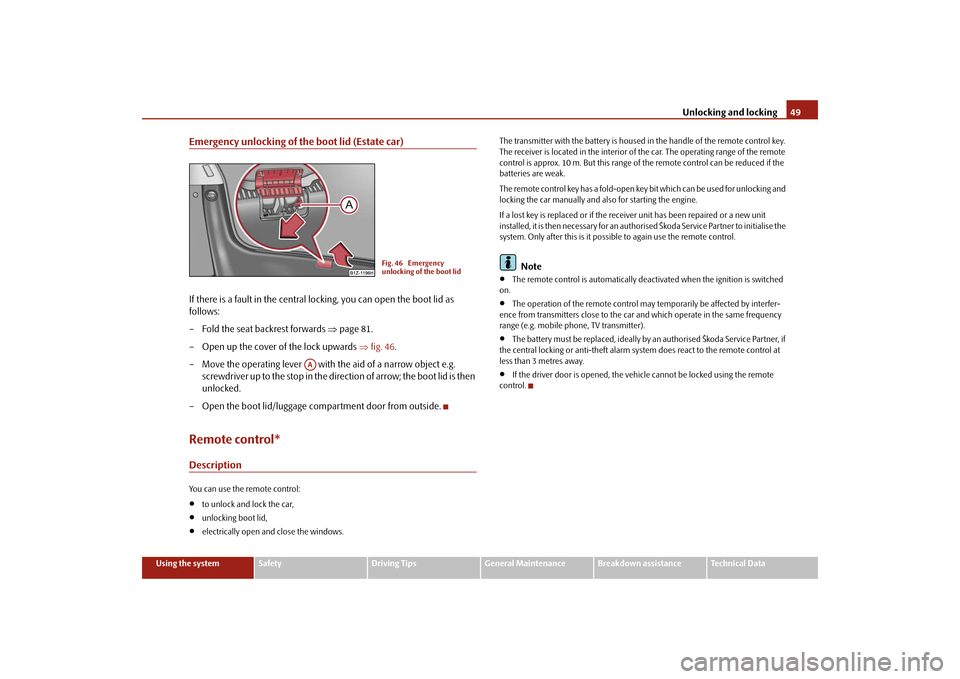
Unlocking and locking
49
Using the system
Safety
Driving Tips
General Maintenance
Breakdown assistance
Technical Data
Emergency unlocking of the boot lid (Estate car)If there is a fault in the central lo
cking, you can open the boot lid as
follows: – Fold the seat backrest forwards
⇒
page 81.
– Open up the cover of the lock upwards
⇒
fig. 46
.
– Move the operating lever with th
e aid of a narrow object e.g.
screwdriver up to the stop in the direction of arrow; the boot lid is then unlocked.
– Open the boot lid/luggage compartment door from outside.Remote control*DescriptionYou can use the remote control:•
to unlock and lock the car,
•
unlocking boot lid,
•
electrically open and close the windows.
The transmitter with the battery is housed in the handle of the remote control key. The receiver is located in the interior of
the car. The operating range of the remote
control is approx. 10 m. But this range of
the remote control can be reduced if the
batteries are weak. The remote control key has a fold-open key
bit which can be used for unlocking and
locking the car manually and also for starting the engine. If a lost key is replaced or if the receiv
er unit has been repaired or a new unit
installed, it is then necessary for an authorised Škoda Service Partner to initialise the system. Only after this is it possib
le to again use the remote control.
Note
•
The remote control is automatically deac
tivated when the ignition is switched
on.•
The operation of the remote control may temporarily be affected by interfer-
ence from transmitters close to the car and which operate in the same frequency range (e.g. mobile phone, TV transmitter).•
The battery must be replaced, ideally by
an authorised Škoda Service Partner, if
the central locking or anti-theft alarm system does react to the remote control at less than 3 metres away.•
If the driver door is opened, the vehicle cannot be locked using the remote
control.
Fig. 46 Emergency unlocking of the boot lid
AA
se0.1.book Page 49 Friday, April 10, 2009 3:19 PM
Page 52 of 304
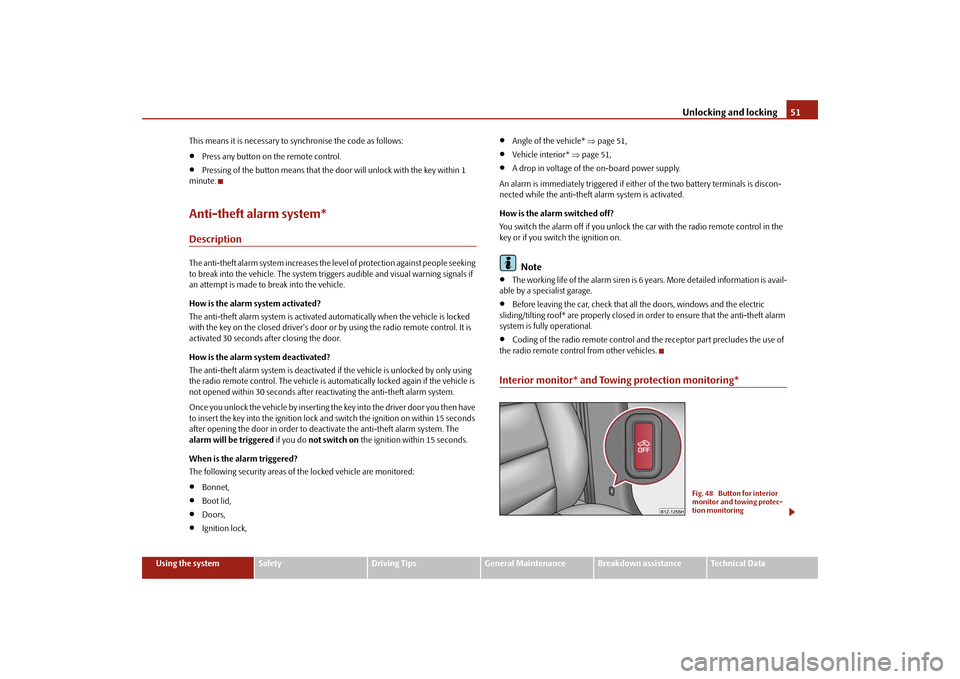
Unlocking and locking
51
Using the system
Safety
Driving Tips
General Maintenance
Breakdown assistance
Technical Data
This means it is necessary to synchronise the code as follows:•
Press any button on the remote control.
•
Pressing of the button means that the
door will unlock with the key within 1
minute.Anti-theft alarm system*DescriptionThe anti-theft alarm system increases the le
vel of protection against people seeking
to break into the vehicle. The system tri
ggers audible and visual warning signals if
an attempt is made to break into the vehicle. How is the alarm system activated? The anti-theft alarm system is activated
automatically when th
e vehicle is locked
with the key on the closed driver's door or
by using the radio remote control. It is
activated 30 seconds after closing the door. How is the alarm system deactivated? The anti-theft alarm system is deactivated
if the vehicle is unlocked by only using
the radio remote control. The vehicle is au
tomatically locked agai
n if the vehicle is
not opened within 30 seconds after reac
tivating the anti-theft alarm system.
Once you unlock the vehicle by inserting the key into the driver door you then have to insert the key into the ignition lock an
d switch the ignition on within 15 seconds
after opening the door in order to deactivate the anti-theft alarm system. The alarm will be triggered
if you do
not switch on
the ignition within 15 seconds.
When is the alarm triggered? The following security areas of the locked vehicle are monitored:•
Bonnet,
•
Boot lid,
•
Doors,
•
Ignition lock,
•
Angle of the vehicle*
⇒page 51,
•
Vehicle interior*
⇒page 51,
•
A drop in voltage of the on-board power supply.
An alarm is immediately triggered if either of the two battery terminals is discon- nected while the anti-theft
alarm system is activated.
How is the alarm switched off? You switch the alarm off if you unlock the car with the radio remote control in the key or if you switch the ignition on.
Note
•
The working life of the alarm siren is 6 years. More detailed information is avail-
able by a specialist garage.•
Before leaving the car, check that all the doors, windows and the electric
sliding/tilting roof* are properly closed in order to ensure that the anti-theft alarm system is fully operational.•
Coding of the radio remote control and
the receptor part precludes the use of
the radio remote control from other vehicles.Interior monitor* and Towing protection monitoring*
Fig. 48 Button for interior monitor and towing protec-tion monitoring
se0.1.book Page 51 Friday, April 10, 2009 3:19 PM
Page 54 of 304
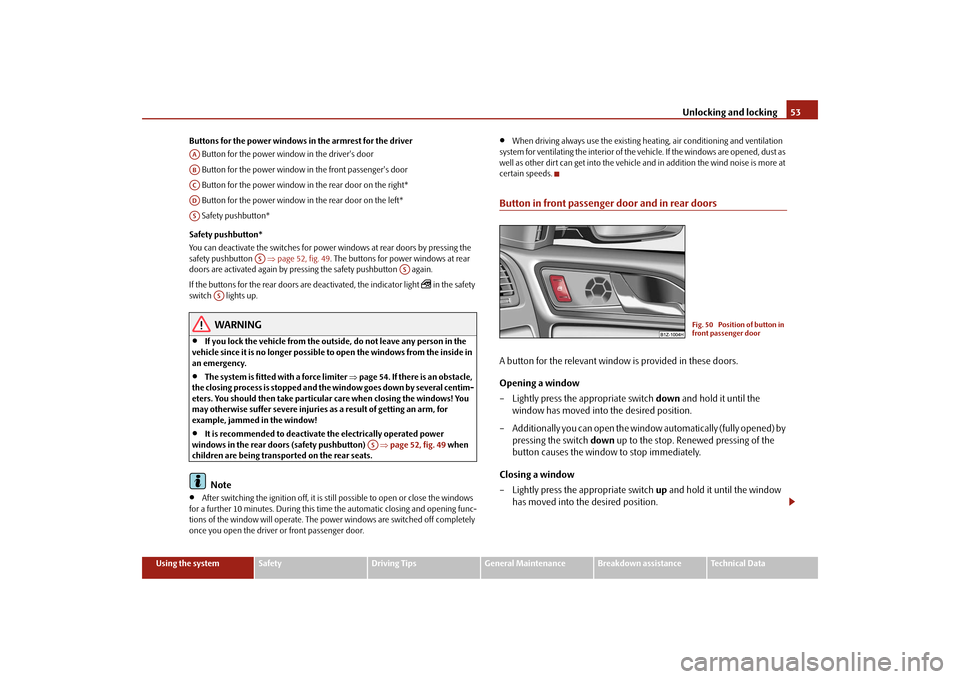
Unlocking and locking
53
Using the system
Safety
Driving Tips
General Maintenance
Breakdown assistance
Technical Data
Buttons for the power windows in the armrest for the driver Button for the power window in the driver's door Button for the power window in the front passenger's door Button for the power window in the rear door on the right* Button for the power window in the rear door on the left* Safety pushbutton* Safety pushbutton* You can deactivate the switches for power
windows at rear door
s by pressing the
safety pushbutton
⇒page 52, fig. 49
. The buttons for power windows at rear
doors are activated again by pressing the safety pushbutton again. If the buttons for the rear doors are deactivated, the indicator light
in the safety
switch lights up.
WARNING
•
If you lock the vehicle from the outside, do not leave any person in the
vehicle since it is no long
er possible to open the windows from the inside in
an emergency.•
The system is fitted with a force limiter
⇒page 54. If there is an obstacle,
the closing process is stopped and the
window goes down by several centim-
eters. You should then take particular care when closing the windows! You may otherwise suffer severe injuries
as a result of getting an arm, for
example, jammed in the window!•
It is recommended to deactivate
the electrically operated power
windows in the rear doors (safety pushbutton)
⇒page 52, fig. 49
when
children are being transported on the rear seats.
Note
•
After switching the ignition off, it is still possible to open or close the windows
for a further 10 minutes. During this time the automatic closing and opening func-tions of the window will operate. The po
wer windows are switched off completely
once you open the driver or front passenger door.
•
When driving always use the existing he
ating, air conditioning and ventilation
system for ventilating the interior of the vehicle. If the windows are opened, dust as well as other dirt can get into the vehicle and in addition the wind noise is more at certain speeds.Button in front passenger door and in rear doorsA button for the relevant window is provided in these doors. Opening a window – Lightly press the appropriate switch
down
and hold it until the
window has moved into the desired position.
– Additionally you can open the window
automatically (fully opened) by
pressing the switch
down
up to the stop. Renewed pressing of the
button causes the window to stop immediately.
Closing a window – Lightly press the appropriate switch
up and hold it until the window
has moved into the desired position.
AAABACADAS
AS
AS
AS
AS
Fig. 50 Position of button in front passenger door
se0.1.book Page 53 Friday, April 10, 2009 3:19 PM
Page 56 of 304

Unlocking and locking
55
Using the system
Safety
Driving Tips
General Maintenance
Breakdown assistance
Technical Data
may otherwise suffer severe injuries
as a result of getting an arm, for
example, jammed in the window!
Note
On vehicles fitted with anti-theft alarm
system the convenience window opening is
possible by means of the key in the lock
ing cylinder only 45 seconds after deacti-
vating the warning system or after ac
tivating the anti-theft alarm system.
Operational faultsElectrically operated power windows do not operate If the battery of the car has been discon
nected and then reconnected, the electri-
cally operated power windows do not oper
ate. The system must be activated.
Proceed as follows in order to re-establish the function:•
Switch on the ignition.
•
Press the relevant switch
top
and hold it pressed as lo
ng as necessary until the
window is closed.•
Release the switch.
•
Press once again the relevant switch
top
and hold it pressed for approx. 3
seconds. Operation in winter Ice accumulating on the surface of the wi
ndows during the winter may result in a
greater resistance when closing the windows and the window may stop and go down several centimetres It is necessary to put the force limiter out of operation in order to close the window ⇒ page 54, “Force limiter of the power windows”.
WARNING
The system is fitted with a force limiter
⇒page 54. If there is an obstacle, the
closing process is stopped and the wi
ndow goes down by several centime-
ters. You should then take particular care when closing the windows! You may otherwise suffer severe injuries as a result of getting an arm, for example, jammed in the window!Electric sliding/tilting roof*DescriptionThe sliding/tilting roof is operated by means of the control dial
⇒fig. 51
and only
functions when the ignition is switched on
. The control dial has a number of fixed
positions. After switching the ignition off, it is still possible to open or close the sliding/tilting roof for a further 10 minutes. It is no long
er possible to operate the sliding/tilting
roof after opening or closing on
e of the front doors, however.
Note
If the battery has been disconnected and reconnected, it is possible that the sliding/tilting roof does not close fully. Here you have to set the control dial to the switch position and press it
forward for about 10 seconds.
WARNING (continued)
WARNING (continued)
Fig. 51 Control dial for the power sliding/tilting roof
AA
se0.1.book Page 55 Friday, April 10, 2009 3:19 PM
Page 58 of 304

Unlocking and locking
57
Using the system
Safety
Driving Tips
General Maintenance
Breakdown assistance
Technical Data
You can close and/or open the sliding/ti
lting roof by hand if the system is
defect. – Position the flat blade of a screwdriver carefully against the rear edge
of the cover of the electrical drive
⇒
page 56, fig. 52
.
– Pull the cover down.– Insert an Allen key, Group 4, up to the stop into the opening and close
and/or open the sliding/tilting roof
⇒
fig. 53
.
– Press on the cover again by first of all inserting the plastic lugs and
then pushing the cover up.
– Have the fault rectified by a specialist workshop.
Note
It is necessary after each emergency operation to move the sliding/tilting roof into the basic position. Here you have to turn th
e control dial forward to the switch posi-
tion
⇒page 55, fig. 51
and press for about 10 seconds.
Fig. 53 Detail of the head- liner: Emergency operation
AA
se0.1.book Page 57 Friday, April 10, 2009 3:19 PM
Page 60 of 304
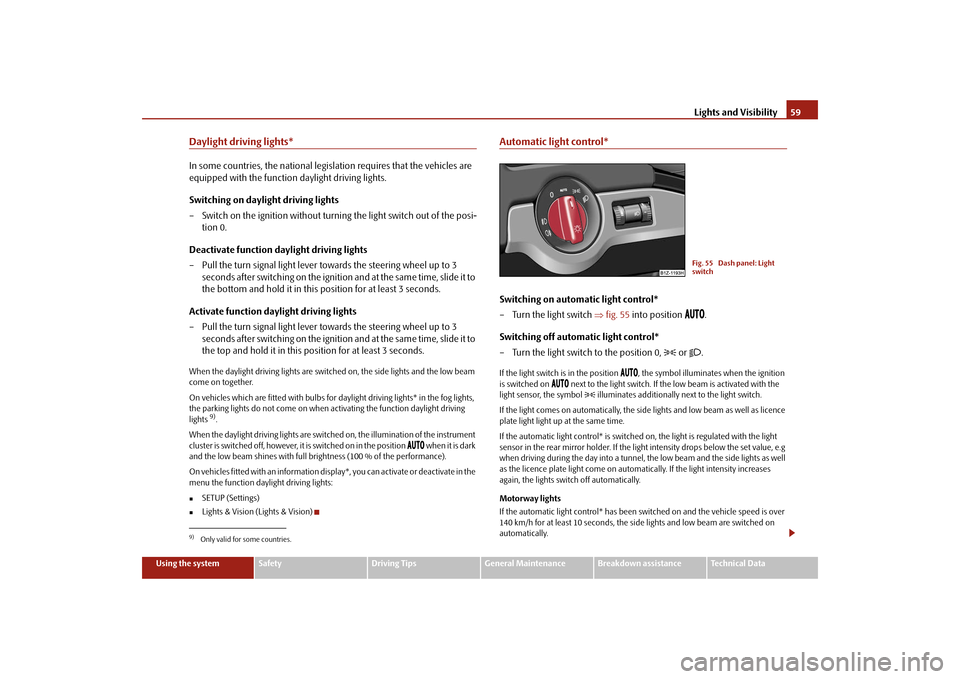
Lights and Visibility
59
Using the system
Safety
Driving Tips
General Maintenance
Breakdown assistance
Technical Data
Daylight driving lights*In some countries, the national legisl
ation requires that the vehicles are
equipped with the function
daylight driving lights.
Switching on daylight driving lights – Switch on the ignition without turnin
g the light switch out of the posi-
tion 0.
Deactivate function daylight driving lights – Pull the turn signal light lever towards the steering wheel up to 3
seconds after switching on the ignition
and at the same time, slide it to
the bottom and hold it in this position for at least 3 seconds.
Activate function daylight driving lights – Pull the turn signal light lever towards the steering wheel up to 3
seconds after switching on the ignition
and at the same time, slide it to
the top and hold it in this position for at least 3 seconds.
When the daylight driving lights are switched on, the side lights and the low beam come on together. On vehicles which are fitted with bulbs for
daylight driving lights* in the fog lights,
the parking lights do not co
me on when activating the function daylight driving
lights
9).
When the daylight driving lights are switched on, the illumination of the instrument cluster is switched off, however, it is switched on in the position
when it is dark
and the low beam shines with full brightness (100 % of the performance). On vehicles fitted with an information displa
y*, you can activate or
deactivate in the
menu the function daylight driving lights:�„
SETUP (Settings)
�„
Lights & Vision (Lights & Vision)
Automatic light control*Switching on automatic light control* – Turn the light switch
⇒
fig. 55
into position
.
Switching off automatic light control* – Turn the light switch to the position 0,
or
.
If the light switch is in the position
, the symbol illuminates when the ignition
is switched on
next to the light switch. If th
e low beam is activated with the
light sensor, the symbol
illuminates additionally next to the light switch.
If the light comes on automatically, the side lights and low beam as well as licence plate light light up at the same time. If the automatic light control* is switched on, the light is regulated with the light sensor in the rear mirror holder. If the light intensity drops below the set value, e.g when driving during the day into a tunnel, the low beam and the side lights as well as the licence plate light come on automa
tically. If the light intensity increases
again, the lights switch off automatically. Motorway lights If the automatic light control* has been sw
itched on and the vehicle speed is over
140 km/h for at least 10 seconds, the side
lights and low beam are switched on
automatically.
9)Only valid for some countries.
Fig. 55 Dash panel: Light switch
se0.1.book Page 59 Friday, April 10, 2009 3:19 PM